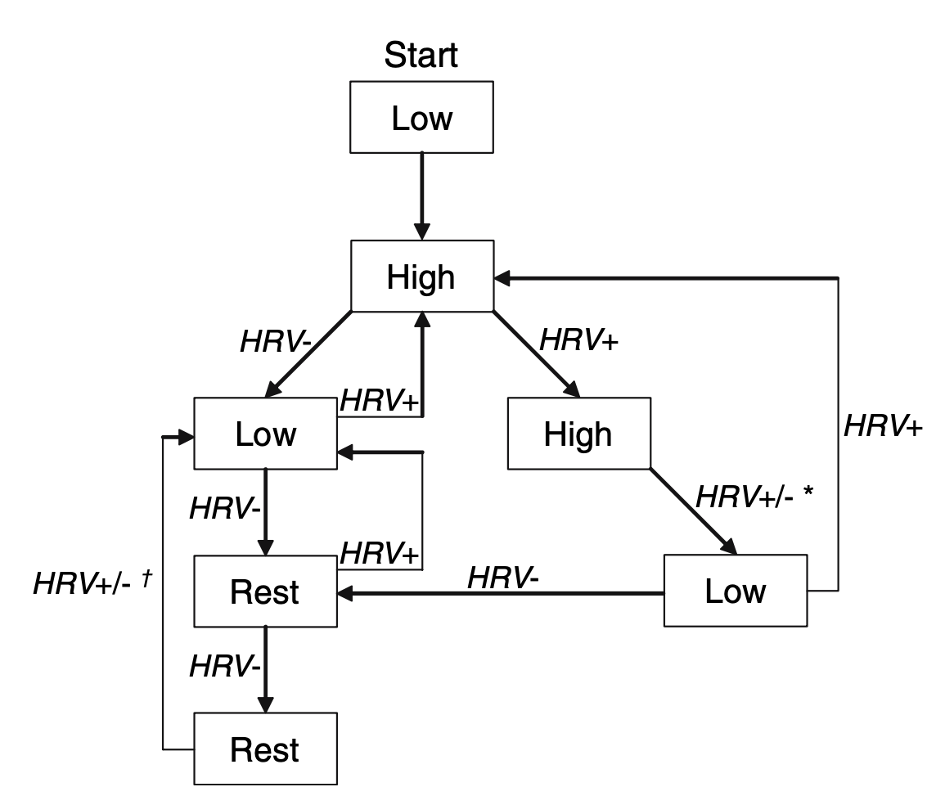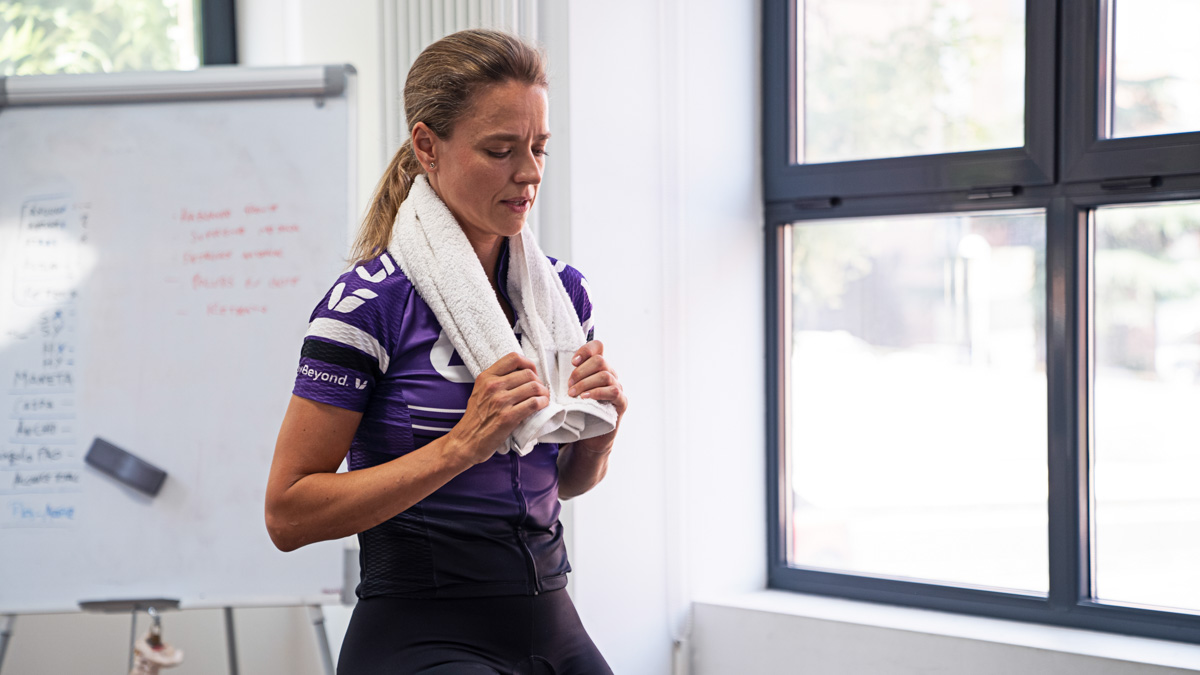In 2009, when for the first time, heart rate variability (HRV) could conveniently be measured using a smartphone app, data-hungry endurance athletes have been experimenting with the best way to use HRV to ensure their valuable training time delivers the most bang for the buck, whilst helping them to stay healthy.
In the short term, recovery of HRV toward baseline following a training-induced dip has been shown to coincide with the restoration of metabolic processes disturbed by physical exercise. Over a period of weeks and months, a higher and more stable HRV baseline is associated with greater training benefits and the ability to tolerate higher loads. These benefits have been shown in well-trained athletes, as well as recreational athletes and even recovering hospital patients.
The simplest way to use HRV in everyday training is to compare a morning HRV reading (taken first thing in a standing or sitting position) with a rolling average baseline. If it’s close to or above baseline, your body is sufficiently recovered to continue with planned training. If the day’s HRV is significantly below, then lower intensity or complete rest are advised, depending on how long the dip has continued.
Researchers have turned this advice into algorithms such as the one developed by Kiviniemi et al., which produced significant increases in maximal running speed in club runners. The ‘Low’ and ‘High’ here refer to low vs. high intensity running in a simple polarized running training program, and the program can be stepped through daily using a morning HRV measurement.

There have now been a few studies comparing HRV-guided training to following a predefined plan. Predefined plans work quite well on average at the group level, but the problem is that no one is exactly “average,” and responses at the individual level can vary from significant increases in fitness to no improvement or even small decreases. The potential for HRV-guided training can include improved consistency in response at the individual level, as well as less of a chance of succumbing to injuries and illness that prevent many athletes from realizing their competition goals. The reduction in illness and injury is achieved because the mechanisms responsible for HRV are closely linked to the body’s immune and inflammatory responses, so backing off from stressful intense training when HRV is below baseline helps safeguard that non-functional overreaching doesn’t occur.
Is HRV Guided Training the Best Option?
Results from some of the studies, such as this one performed on well-trained cyclists, led to significant gains in power at anaerobic threshold and benefits in 40-minute time trial power in HRV-guided participants compared to smaller or even negative benefits for cyclists on a standard predefined plan.
Recently, a meta-analysis of 10 HRV-guided studies has looked in more detail at 10 small-scale studies which have all used variations on the original Kiviniemi algorithm, and it’s worth looking at what they found:

The Benefits of HRV Training
• HRV-guided training consistently led to a significant improvement in HRV, which has itself been linked in other studies to long-term improvements in aerobic capacity, resilience and health.
• Although the studies included in the review were all quite short-term (less than eight weeks), a pooled analysis across them all showed modest effects in favor of HRV-guided training for improving maximal aerobic capacity, aerobic capacity at anaerobic threshold (VT2) and overall endurance performance.
• By adjusting training based on HRV and reducing daily fluctuations, individual HRV responses associated with improved adaptation and greater health, i.e., greater aerobic fitness improvements and reduced timeout to illness and injury, are likely to be facilitated.
The Drawbacks of HRV Training
• The effect of guided training depended on the HRV index used. In short, training prescriptions that used the RMSSD time-domain index worked better than when the frequency-domain HF index was used. This may be due to the HF index being more dependent on breathing patterns than RMSSD.
• The effect of position on HRV. For endurance athletes especially, it’s considered that the standing position is more sensitive than lying down, where parasympathetic saturation can mean there is little or no change in measured HRV from one day to the next despite actual changes in recovery.
• Approaches to creating baseline HRV and assessing trends are inconsistent. Best practice suggests a rolling seven to 10-day average can identify trends in the presence of daily fluctuations.
Conclusions on HRV Training
Thousands of recreational, age group and professional athletes have tried monitoring HRV, and many of those have found it useful to help them avoid non-functional overreaching and illness. Consistency in measurement is key, though, as HRV can be a “noisy” measure with unexplained fluctuations. The best practice is to use a validated app and sensor in the standing position every morning, which uses the RMSSD HRV index and creates a seven to 10-day rolling average baseline for the reliable detection of trends.
The HRV-guided techniques reviewed are simple, “if HRV is low do this…” or “if HRV high do that…” algorithms. It’s likely that a more sophisticated approach using machine learning that considers the athlete’s recent training history, acute and chronic training load, the preparation phase they are in, and daily wellness factors could deliver greater benefits through a higher degree of individualization than has been tried so far.
References
Stanley, J.; Peake, J.M.; Buchheit, M. Cardiac Parasympathetic Reactivation Following Exercise: Implications for Training Prescription. Sports Med. 2013, 43, 1259–1277
Manresa-Rocamora, A.; Sarabia, J.M.; Javaloyes, A.; Flatt, A.A.; Moya-Ramón, M. Heart Rate Variability-Guided Training for Enhancing Cardiac-Vagal Modulation, Aerobic Fitness and Endurance Performance: A Methodological Systematic Review with Meta-Analysis. Int. J. Environ. Res. Public Health 2021, 18, 10299
Kiviniemi AM, Hautala AJ, Kinnunen H, Tulppo MP. Endurance training guided individually by daily heart rate variability measurements. Eur J Appl Physiol. 2007 Dec.;101(6):743-51








